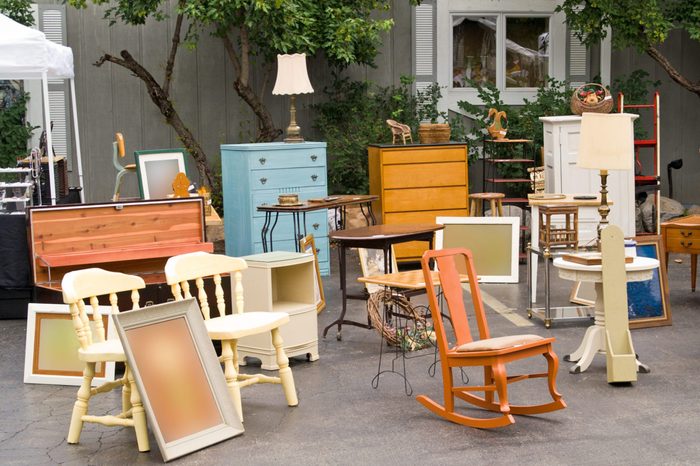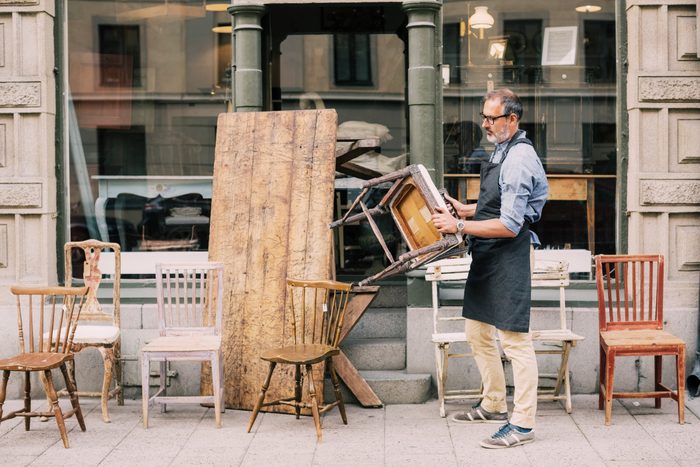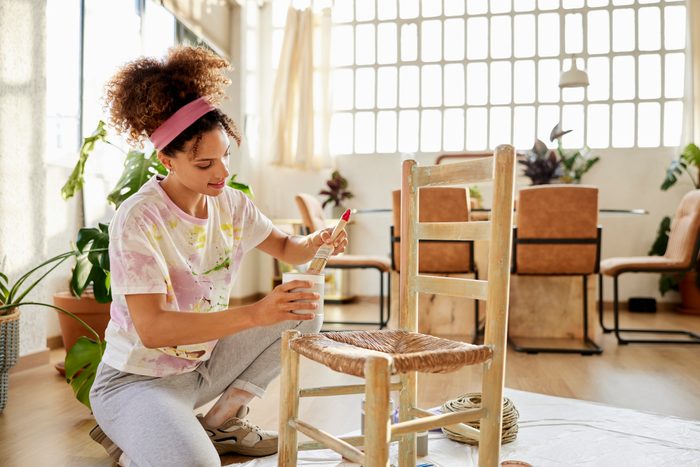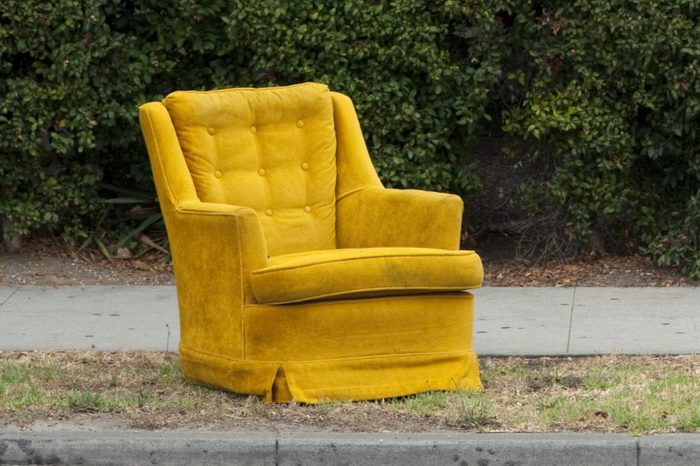Wondering what to do with furniture you no longer need or want? You've got plenty of options.

8 Ways To Get Rid of Old Furniture


Sell at a Garage or Estate Sale
Garage sales are a great way to get rid of old furniture while making a few bucks. The downsides involve time — the back-and-forth of negotiating and the effort to move your furniture to the sale site and stick around for the actual sale.
Running a successful garage sale is something of a science that may seem like overkill if you only have a few pieces of furniture to get rid of. Ask around your neighborhood; you may find neighbors in the same position. Join forces to organize a community sale to potentially draw a bigger crowd and pick up some assistance in running the event.

Estate Sale
Garage sales are great if you have a reasonable amount of items to sell. But if you want professional assistance or have an entire houseful of goods to get rid of, consider contacting an estate sale company. They can manage the details, handle payments and run the actual event. Estate sales are particularly popular when families dealing with the loss of a loved one need space to grieve and process rather than negotiate prices or make changes.

Sell (or Offer Up) Online
Online marketplaces revolutionized the secondhand furniture market. Major platforms include eBay and Facebook Marketplace. Both offer a staggering number of users — around 133 million for eBay and 1.185 billion for Facebook Marketplace — so chances are you’ll find a buyer for even the most unusual furniture.
No matter which platform you choose, be prepared to invest time in taking pictures, writing descriptions and possibly answering buyer questions.
Bonnie Borromeo Tomlinson, home organizer and author of Stop Buying Bins, offers another suggestion: “Utilize your local area Facebook Buy Nothing page. You can post what you’re giving away and someone comes and picks it up.” This streamlines the whole process, with no money changing hands.

Sell on Consignment or at a Second-Hand Store
If your old furniture is in particularly good condition or collectible, consignment is a great option. Again, do your research. Each store features a different audience, price structure and policies, and one may be a better fit than the rest.
It’s worth taking a moment to draw a distinction between consignment and second-hand stores. Per Borromeo Tomlinson: “A [second-hand] shop owner purchases items to resell. They tend to be curated to the tastes of the shop owner, not necessarily vintage or antique.” At consignment shops, she says, “individuals contract with the store owner to sell items on their behalf. Proceeds are paid on a percentage split, typically 60/40.”
Whether you’re considering a direct sale to a retailer or consignment, ask what kind of furniture will a store accept, and their payment terms. If selling on consignment, ask what percentage do they take from the sales, and what happens if no one buys it?
Willow Wright owns Urban Redeux, a treasure trove of unique, vintage home furnishings in Alexandria, Virginia. She suggests reaching out to retailers near you.
“Check if there are any local antique or vintage stores in your area that accept items on consignment or as donations,” she says. “Some stores, like ours, may make exceptions for rare and special pieces that align with their shop’s aesthetic.”

Donate to a Charity
Donating to a charity provides the most socially responsible way to dispose of gently used furniture. The furniture will head to a good home, and you may get a tax deduction for your trouble.
Recycling resource Earth911 largely provides information on recycling. But if you enter “furniture” into their recycling search page, you’ll get a list of nearby charitable organizations that accept furniture, like Goodwill and Habitat for Humanity’s ReStore.
Wright is a big fan of charitable furniture donations, which keep lightly-used pieces out of landfills while contributing to the community. “Thrift/charity stores play a crucial role in supporting local hospitals and nonprofits,” she says.
When you contact the charity, ask what furniture the organization accepts. Will they pick it up, or must you arrange delivery? And always request a receipt for your taxes.

Recycle
It’s not always possible to recycle furniture. Recycling materials need to be stripped down to their parts, and that’s hard to do with furniture. Before you send your old furniture to the landfill, check out these inspiring upcycling furniture ideas for cabinets, chairs, sofas, and more!
Earth911 provides free resources for those hoping to recycle household materials. But don’t expect miracles.
Per its website: “The reality is that furniture is not designed to be easily recycled, and the costs of processing often outweigh the value of materials. Most of the wood used in furniture is treated with paint or varnish, which means it can’t be composted. As a result, most furniture that can’t be reused will end up in a landfill.”
Exceptions include all-metal or all-plastic patio furniture, which can sometimes be recycled.

Repurpose or Upcycle
For many DIYers, upcycling is something of a sweet spot. You can get rid of old furniture while tackling a fun household project.
Dedicated furniture upcycler Diana Cox of TheGardeningTalk.com urges DIYers to get creative.
“With a little time and elbow grease, old furniture can gain new life and purpose while keeping waste out of landfills,” she says. “I’ve made planters from old dressers, storage benches from headboards and side tables from chairs.”
Cox also suggests repurposing old pieces as outdoor patio furniture. If you don’t have a project in mind, break down the furniture into raw materials and store it for use in future projects.

Ask a Contractor or Mover to Haul It Away
If you’re already working with a contractor or mover, they can often bundle furniture removal into a larger job. You’ll likely pay a little for the service, but it’ll be done and you can get on with your life.
As vice president of market operations for Bellhop Atlanta Movers, Nick Valentino often hears from customers who don’t want to move all their furniture or who find abandoned furniture in their new homes. “We’re already there with a truck that will be coming back empty,” Valentino says, “so it’s fairly affordable for us.”
For $20 per item, Valentino and his crew will take away the furniture, but it’s not headed to the landfill.
“We have a few outlets for the furniture,” Valentino says. “I have a friend who upcycles old pieces, and she loves to buy items from us. We advertise some pieces through Facebook Marketplace if we think they can get a good return, and we also have a connection with a local charity that focuses on helping people start new lives after serving time in prison.”

Arrange for Pickup and Disposal
Unfortunately, not all furniture can be saved. You can certainly throw it in the back of a truck and take it down to the local landfill yourself, but the time and effort involved can be demanding. That’s why many people hire a junk hauler.
Prices vary by region and vendor, but expect to pay a private hauler at least $80 to $120 per bulky item (sofa, table, etc). If you have multiple pieces, consider a roll-away dumpster instead. These larger containers can hold a great deal of material, an economical option for multiple rooms worth of furniture. Roll-aways cost $200 to $300, although you’ll fill it on your own.
If you only have a single item to dispose of, contact your local trash collection services first. Your trash service often includes a limited number of bulk collections, or comes with a minimal fee.
About the Experts
- Nick Valentino is the vice president of market operations for Bellhop Atlanta Movers.
- Bonnie Borromeo Tomlinson is a home organizer and the author of Stop Buying Bins.
- Willow Wright owns Urban Redeux, a treasure trove of unique, vintage home furnishings in Alexandria, Virginia.
- Diana Cox is a dedicated furniture upcycler as well as the founder and owner of TheGardeningTalk.com.



















